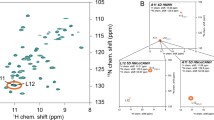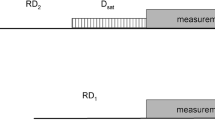Abstract
Paramagnetic relaxation enhancements (PREs) are routinely used to provide long-range distance restraints for the determination of protein structures, to resolve protein dynamics, ligand–protein binding sites, and lowly populated species, using Nuclear Magnetic Resonance Spectroscopy (NMR). Here, we propose a simultaneous 1H-15 N, 1H-13C SESAME based pulse scheme for the rapid acquisition of 1HC/N-R2 relaxation rates for the determination of backbone and sidechain PREs of proteins. The 1HN-R2 rates from the traditional and our approach on Ubiquitin (UBQ) are well correlated (R2 = 0.99), revealing their potential to be used quantitatively. Comparison of the S57C UBQ calculated and experimental PREs provided backbone and side chain Q factors of 0.23 and 0.24, respectively, well-fitted to the UBQ NMR structure, showing that our approach can be used to acquire accurate PRE rates from the functionally important sites of proteins but in at least half the time as traditional methods.





Similar content being viewed by others
References
Allison JR, Rivers RC, Christodoulou JC, Vendruscolo M, Dobson CM (2014) A relationship between the transient structure in the monomeric state and the aggregation propensities of α-synuclein and β-synuclein. Biochemistry 53:7170–7183
Bermejo GA, Strub M-P, Ho C, Tjandra N (2009) Determination of the solution-bound conformation of an amino acid binding protein by NMR paramagnetic relaxation enhancement: use of a single flexible paramagnetic probe with improved estimation of its sampling space. J Am Chem Soc 131:9532–9537
Bermejo GA, Strub M-P, Ho C, Tjandra N (2010) Ligand-free open− closed transitions of periplasmic binding proteins: the case of glutamine-binding protein. Biochemistry 49:1893–1902
Bernadó P, Blackledge M (2010) Proteins in dynamic equilibrium. Nature 468:1046–1048
Bloembergen N (1957) Proton relaxation times in paramagnetic solutions. J Chem Phys 27:572–573
Boehr DD, Nussinov R, Wright PE (2009) The role of dynamic conformational ensembles in biomolecular recognition. Nat Chem Biol 5:789–796
Boswell ZK, Latham MP (2018) Methyl-based NMR spectroscopy methods for uncovering structural dynamics in large proteins and protein complexes. Biochemistry 58:144–155
Cave JW et al (2001) Solution nuclear magnetic resonance structure of a protein disulfide oxidoreductase from Methanococcus jannaschii. Protein Sci 10:384–396
Choy W-Y, Shortle D, Kay LE (2003) Side chain dynamics in unfolded protein states: an NMR based 2H spin relaxation study of Δ131Δ. J Am Chem Soc 125:1748–1758
Clore GM, Iwahara J (2009) Theory, practice, and applications of paramagnetic relaxation enhancement for the characterization of transient low-population states of biological macromolecules and their complexes. Chem Rev 109:4108–4139
Clore GM, Tang C, Iwahara J (2007) Elucidating transient macromolecular interactions using paramagnetic relaxation enhancement. Curr Opin Struct Biol 17:603–616
Cornilescu G, Marquardt JL, Ottiger M, Bax A (1998) Validation of protein structure from anisotropic carbonyl chemical shifts in a dilute liquid crystalline phase. J Am Chem Soc 120:6836–6837
Delaglio F et al (1995) NMRPipe: a multidimensional spectral processing system based on UNIX pipes. J Biomol NMR 6:277–293
Gaponenko V et al (2000) Protein global fold determination using site-directed spin and isotope labeling. Protein Sci 9:302–309
Goddard TD, Kneller DG (2006) Sparky—NMR assignment and integration software. Univ, Calif
Güntert P, Schaefer N, Otting G, Wüthrich K (1993) POMA: A complete Mathematica implementation of the NMR product-operator formalism. J Magn Reson 101:103
Hallenga K, Lippens GM (1995) A constant-time 13 C− 1 H HSQC with uniform excitation over the complete 13 C chemical shift range. J Biomol NMR 5:59–66
Henzler-Wildman K, Kern D (2007) Dynamic personalities of proteins. Nature 450:964–972
Iwahara J, Clore GM (2010) Structure-independent analysis of the breadth of the positional distribution of disordered groups in macromolecules from order parameters for long, variable-length vectors using NMR paramagnetic relaxation enhancement. J Am Chem Soc 132:13346–13356
Iwahara J, Anderson DE, Murphy EC, Clore GM (2003) EDTA-derivatized deoxythymidine as a tool for rapid determination of protein binding polarity to DNA by intermolecular paramagnetic relaxation enhancement. J Am Chem Soc 125(22):6634–6635
Iwahara J, Schwieters CD, Clore GM (2004) Ensemble approach for NMR structure refinement against 1H paramagnetic relaxation enhancement data arising from a flexible paramagnetic group attached to a macromolecule. J Am Chem Soc 126:5879–5896
Iwahara J, Tang C, Clore GM (2007) Practical aspects of 1H transverse paramagnetic relaxation enhancement measurements on macromolecules. J Magn Reson 184:185–195
Kay LE (2016) New views of functionally dynamic proteins by solution NMR spectroscopy. J Mol Biol 428:323–331
Kleckner IR, Foster MP (2011) An introduction to NMR-based approaches for measuring protein dynamics. Biochim. Biophys. Acta (BBA)-Proteins Proteomics 1814:942–968
Kussell E, Shimada J, Shakhnovich EI (2003) Side-chain dynamics and protein folding. Proteins Struct Funct Bioinforma 52:303–321
Law AB, Fuentes EJ, Lee AL (2009) Conservation of side-chain dynamics within a protein family. J Am Chem Soc 131:6322–6323
Lee AL, Kinnear SA, Wand AJ (2000) Redistribution and loss of side chain entropy upon formation of a calmodulin–peptide complex. Nat Struct Biol 7:72–77
Lichtenecker RJ, Weinhäupl K, Schmid W, Konrat R (2013) α-Ketoacids as precursors for phenylalanine and tyrosine labelling in cell-based protein overexpression. J Biomol NMR 57:327–331
Lichtenecker RJ et al (2013) Independent valine and leucine isotope labeling in Escherichia coli protein overexpression systems. J Biomol NMR 57:205–209
Long D, Li D-W, Walter KFA, Griesinger C, Brüschweiler R (2011) Toward a predictive understanding of slow methyl group dynamics in proteins. Biophys J 101:910–915
Mackenzie HW, Hansen DF (2019) Arginine side-chain hydrogen exchange: quantifying arginine side-chain interactions in solution. ChemPhysChem 20:252–259
Madl T, Felli IC, Bertini I, Sattler M (2010) Structural analysis of protein interfaces from 13C direct-detected paramagnetic relaxation enhancements. J Am Chem Soc 132:7285–7287
Mateos B, Konrat R, Pierattelli R, Felli IC (2019) NMR characterization of long-range contacts in intrinsically disordered proteins from paramagnetic relaxation enhancement in 13C direct-detection experiments. ChemBioChem 20:335–339
Millet O, Muhandiram DR, Skrynnikov NR, Kay LE (2002) Deuterium spin probes of side-chain dynamics in proteins. 1. Measurement of five relaxation rates per deuteron in 13C-labeled and fractionally 2H-enriched proteins in solution. J. Am. Chem. Soc. 124:6439–6448
Mishra P, Barnes CA, Strickland M, Tjandra N (2018) Solvent saturation transfer to proteins (SSTP) for structural and functional characterization of proteins. J Biomol NMR 70:11–20
Nolis P, Perez M, Parella T (2006) Time-sharing evolution and sensitivity enhancements in 2D HSQC-TOCSY and HSQMBC experiments. Magn Reson Chem 44:1031–1036
Otten R, Villali J, Kern D, Mulder FAA (2010) Probing Microsecond Time Scale Dynamics in Proteins by Methyl 1H Carr− Purcell− Meiboom− Gill Relaxation Dispersion NMR Measurements. Application to Activation of the Signaling Protein NtrC r. J. Am. Chem. Soc. 132:17004–17014
Pulses, Gauss. Acronym for Globally Optimized Alternating Phase Rectangular Pulse The GARP sequence [lJ has been applied in nuclear magnetic resonance (see NMR) for heteronuclear decoupling of nuclei with wide chemical shift (see CS) regions. Decoupling can be realized . (1990).
Puthenveetil R, Vinogradova O (2019) Solution NMR: A powerful tool for structural and functional studies of membrane proteins in reconstituted environments. J Biol Chem 294:15914–15931
Ruschak AM, Kay LE (2010) Methyl groups as probes of supra-molecular structure, dynamics and function. J Biomol NMR 46:75
Sattler M, Fesik SW (1996) Use of deuterium labeling in NMR: overcoming a sizeable problem. Structure 4:1245–1249
Sattler M, Maurer M, Schleucher J, Griesinger C (1995) A simultaneous 15 N, 1 H-and 13 C, 1 H-HSQC with sensitivity enhancement and a heteronuclear gradient echo. J Biomol NMR 5:97–102
Schörghuber J et al (2015) Novel approaches in selective tryptophan isotope labeling by using Escherichia coli overexpression media. ChemBioChem 16:746–751
Schörghuber J, Geist L, Platzer G, Konrat R, Lichtenecker RJ (2017) Highly Selective Stable Isotope Labeling of Histidine Residues by Using a Novel Precursor in E. coli-Based Overexpression Systems. ChemBioChem 18:1487–1491
Schörghuber J et al (2017) Anthranilic acid, the new player in the ensemble of aromatic residue labeling precursor compounds. J Biomol NMR 69:13–22
Schwieters CD, Kuszewski JJ, Tjandra N, Clore GM (2003) The Xplor-NIH NMR molecular structure determination package. J Magn Reson 160:65–73
Shaka AJ, Keeler J, Freeman R (1983) Evaluation of a new broadband decoupling sequence: WALTZ-16. J Magn Reson 53:313–340
Skrynnikov NR, Mulder FAA, Hon B, Dahlquist FW, Kay LE (2001) Probing slow time scale dynamics at methyl-containing side chains in proteins by relaxation dispersion NMR measurements: application to methionine residues in a cavity mutant of T4 lysozyme. J Am Chem Soc 123:4556–4566
Skrynnikov NR, Millet O, Kay LE (2002) Deuterium spin probes of side-chain dynamics in proteins. 2. Spectral density mapping and identification of nanosecond time-scale side-chain motions. J. Am. Chem. Soc. 124:6449–6460
Solomon I (1955) Relaxation processes in a system of two spins. Phys Rev 99:559
Trbovic N et al (2009) Protein side-chain dynamics and residual conformational entropy. J Am Chem Soc 131:615–622
Tugarinov V, Kay LE (2005) Methyl groups as probes of structure and dynamics in NMR studies of high-molecular-weight proteins. ChemBioChem 6:1567–1577
Tzeng S-R, Pai M-T, Kalodimos CG (2012) NMR studies of large protein systems. In: Shekhtman A, Burz DS (eds) Protein NMR Techniques. Springer, New York, pp 133–140
Vuister GW, Bax A (1992) Resolution enhancement and spectral editing of uniformly 13C-enriched proteins by homonuclear broadband 13C decoupling. J Magn Reson. https://doi.org/10.1016/0022-2364(92)90144-V
Werbeck ND, Kirkpatrick J, Hansen DF (2013) Probing arginine side-chains and their dynamics with carbon-detected NMR spectroscopy: application to the 42 kDa human histone deacetylase 8 at high pH. Angew Chemie 125:3227–3229
Würtz P, Permi P (2007) SESAME-HSQC for simultaneous measurement of NH and CH scalar and residual dipolar couplings. Magn Reson Chem 45:289–295
Yu D, Volkov AN, Tang C (2009) Characterizing Dynamic Protein− Protein Interactions Using Differentially Scaled Paramagnetic Relaxation Enhancement. J Am Chem Soc 131:17291–17297
Acknowledgements
We would like to thank Dr. Duck-Yeon Lee of the Biochemistry Core at NHLBI for his assistance in the LC-MS data acquisition and analysis. We also would like to thank Dr. Marie-Paule Strub for her assistance in producing the mutant plasmids of Ubiquitin.
Funding
This work was supported by the Intramural Research Program of the NHLBI, NIH.
Author information
Authors and Affiliations
Contributions
Conceived and designed the experiments: PM, NT. Performed the experiments: AB, MS and PM. Analyzed the data: PM, AB, NT, MS. Contributed reagents/materials/analysis tools: AB, NT. Wrote the paper: PM, AB.
Corresponding author
Ethics declarations
Conflict of interest
Each author has provided final approval of the manuscript and declares that they have no conflicts of interest with the contents of this article.
Additional information
Publisher's Note
Springer Nature remains neutral with regard to jurisdictional claims in published maps and institutional affiliations.
Supplementary Information
Below is the link to the electronic supplementary material.
Rights and permissions
About this article
Cite this article
Barnes, C.A., Starich, M.R., Tjandra, N. et al. Simultaneous measurement of 1HC/N-R2′s for rapid acquisition of backbone and sidechain paramagnetic relaxation enhancements (PREs) in proteins. J Biomol NMR 75, 109–118 (2021). https://doi.org/10.1007/s10858-021-00359-9
Received:
Accepted:
Published:
Issue Date:
DOI: https://doi.org/10.1007/s10858-021-00359-9




